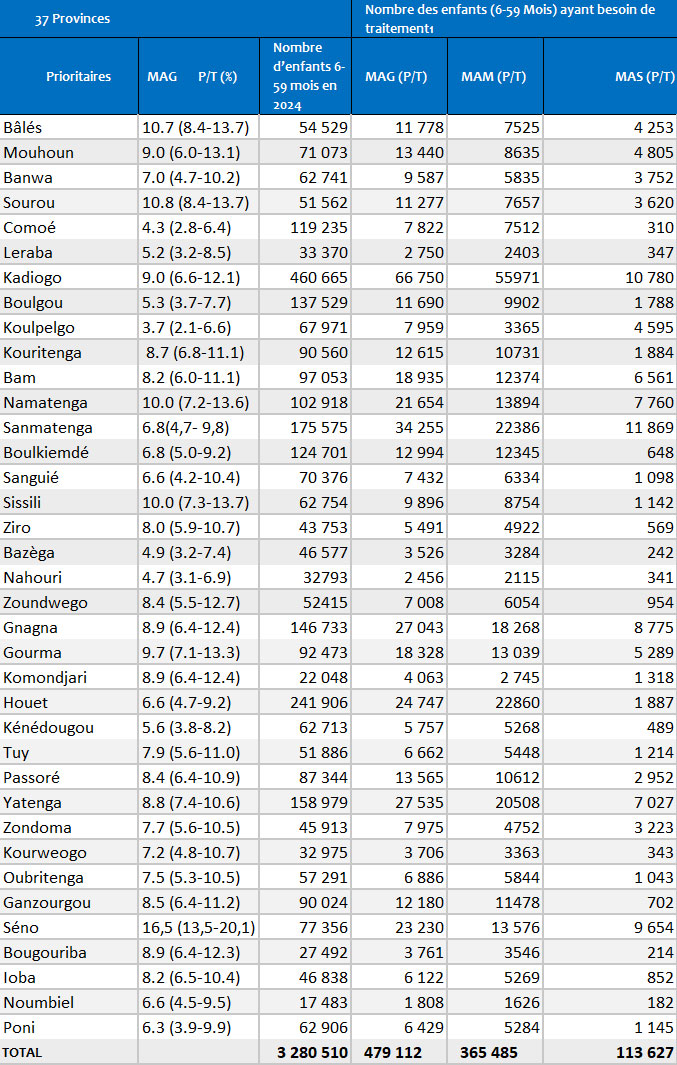02.01.2024
01.08.2023 > 31.07.2024
Map
Projected Map
Other Projections




Key
results
Population
estimates
Recommendations
& next steps
Acute
Malnutrition
Between August 2023 and July 2024, 480,000 children aged 6 to 59 months and almost 131,500 pregnant and breastfeeding women (PBW) are facing/expected to face elevated levels of acute malnutrition in the 37 provinces analysed. This includes 113,627 cases of severe acute malnutrition (SAM).
In the current period of August 2023 – January 2024 (peak of malnutrition), seven provinces are classified in IPC AMN Phase 3 (Serious). In the first projection period (February to April 2024) that figure will improve significantly, with four provinces moving from Phase 3 to IPC AMN Phase 2 (Alert). However, the second projection period will see a marked deterioration, with 13 provinces moving to higher IPC AMN phases. Five provinces will move from IPC AMN Phase 1 (Acceptable) to Phase 2, seven provinces will move from Phase 2 to Phase 3 and one province will move from Phase 3 to IPC AMN Phase 4 (Critical). None of the provinces will see their situation improve.
The main contributing factors to the acute malnutrition are low food consumption, poor dietary and care practices, high prevalence of childhood morbidities – fever, diarrhea, and acute respiratory infections – poor hygiene and sanitation conditions and the low coverage of access to drinking water.
The security crisis prevailing in the country has caused negative effects such as massive population displacement in eight of the 13 regions and the closure/malfunction of more than 500 health structures in provinces with limited humanitarian access.
Country Related Information
Contacts
- 01.08.2024 > 31.07.2025
Burkina Faso: Acute Malnutrition Situation August 2024 - January 2025 and Projections for February - April 2025 and May - July 2025 - 01.08.2022 > 31.07.2023
Burkina Faso: Acute Malnutrition Situation August 2022 - January 2023 and Projections for February - April 2022 and May - July 2023 - 01.08.2021 > 31.07.2022
Burkina Faso: Acute Malnutrition Situation August 2021 - January 2022 and Projections for February - April 2022 and May - July 2022 - 01.10.2020 > 31.07.2021
Burkina Faso: Acute Malnutrition Situation October 2020 - January 2021 and Projections for February - April 2021 and May - July 2021 - 01.04.2020 > 31.07.2020
Burkina Faso: Acute Malnutrition Projection Update April - July 2020 - 01.08.2019 > 31.07.2020
Burkina Faso: Acute Malnutrition Situation August - November 2019 and Projections for December 2019 - March 2020 and April - July 2020
- 25.10.2023 > 28.10.2023
Burkina Faso: Acute Malnutrition Analysis - 26.10.2022 > 08.11.2022
Burkina Faso: Acute Malnutrition Analysis - 25.05.2020 > 30.05.2020
VIRTUAL Burkina Faso: Acute Malnutrition Update of the Projection confirmed - 31.01.2020 > 06.02.2020
Burkina Faso: Acute Malnutrition Analysis
Join our mailing list


